Abstract
The tonsil of the soft palate, the predominant lymphoid tissue of the oropharynx in pigs, is important especially in initiating immune responses against antigenic material entering the mouth. The aim of this work was to describe the lymphatic pathways from the tonsils of the soft palate of pigs through lymph nodes of the head to the bloodstream. This was achieved by gross dissection, and by using Evans' Blue dye and Microfil casts. Efferent lymphatic vessels from the tonsil coalesce to form vessels which convey lymph to the primary nodes, the mandibular and medial retropharyngeal, and thence to the bloodstream, along two distinct pathways. In the superficial pathway, lymph flows through the mandibular lymph node, along lymphatic vessels closely associated with the linguofacial vein, to the ventral superficial cervical node (middle group) and the accessory mandibular node. Most efferent vessels from the accessory mandibular node enter the ventral superficial cervical node, but some may directly join the lymphatic vessels emanating from the ventral superficial cervical node. These vessels convey lymph to the dorsal superficial cervical node and thence, via the efferent lymphatics, to the circulatory system. In the deep pathway, lymph is conveyed directly to the medial retropharyngeal node and then to the tracheal trunk, as in other domestic animals. As the vessels from the tonsils course over the surface of the pharynx, the muscular movements of swallowing may help propel lymph towards the primary nodes and the bloodstream.
Full text
PDF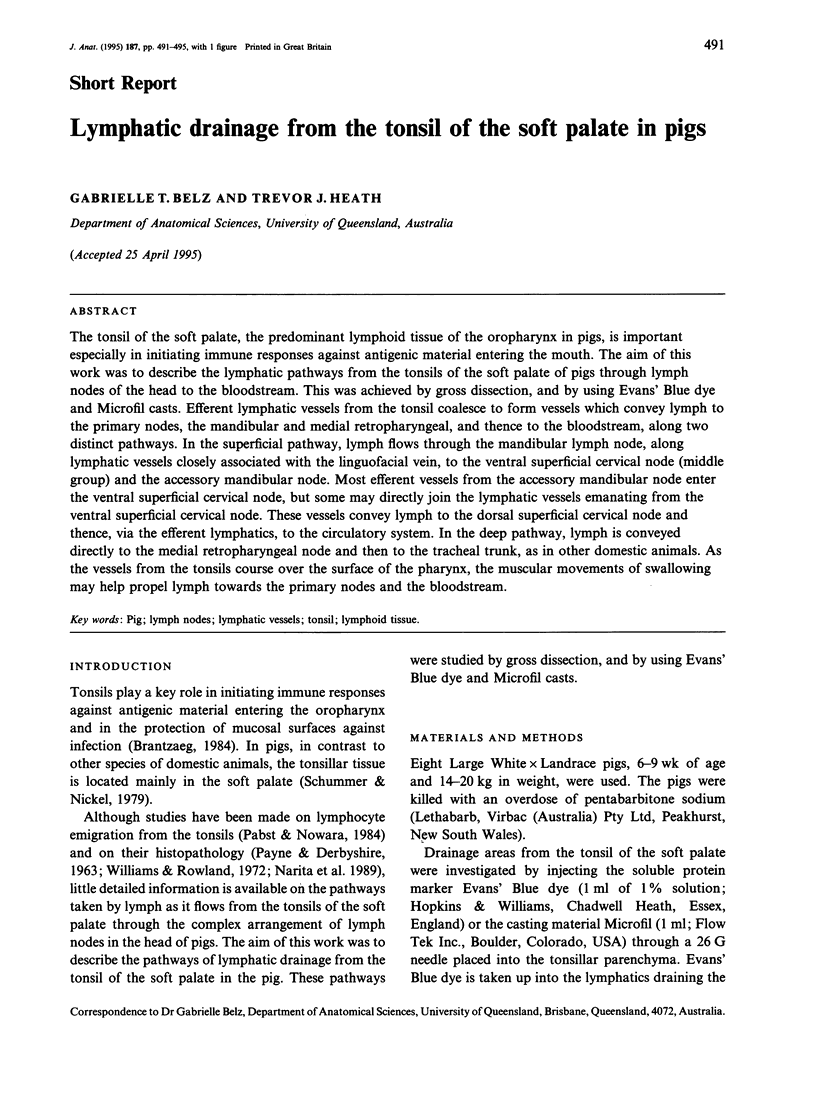
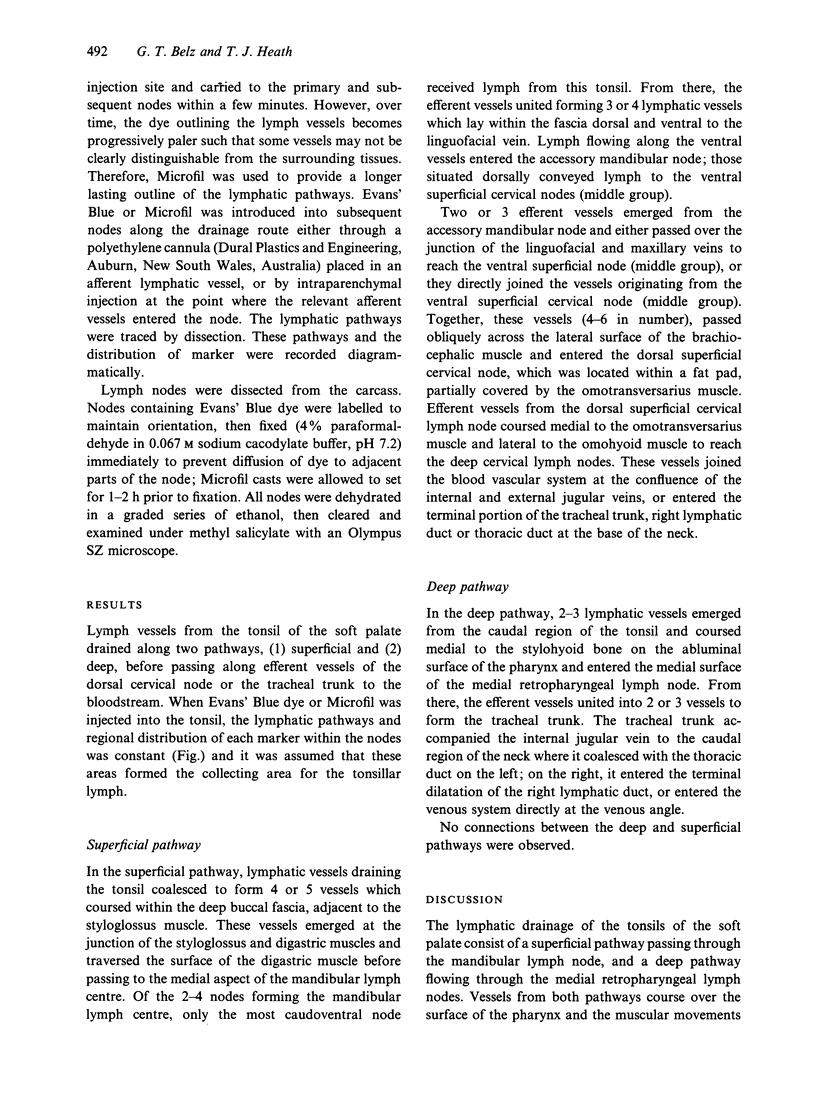
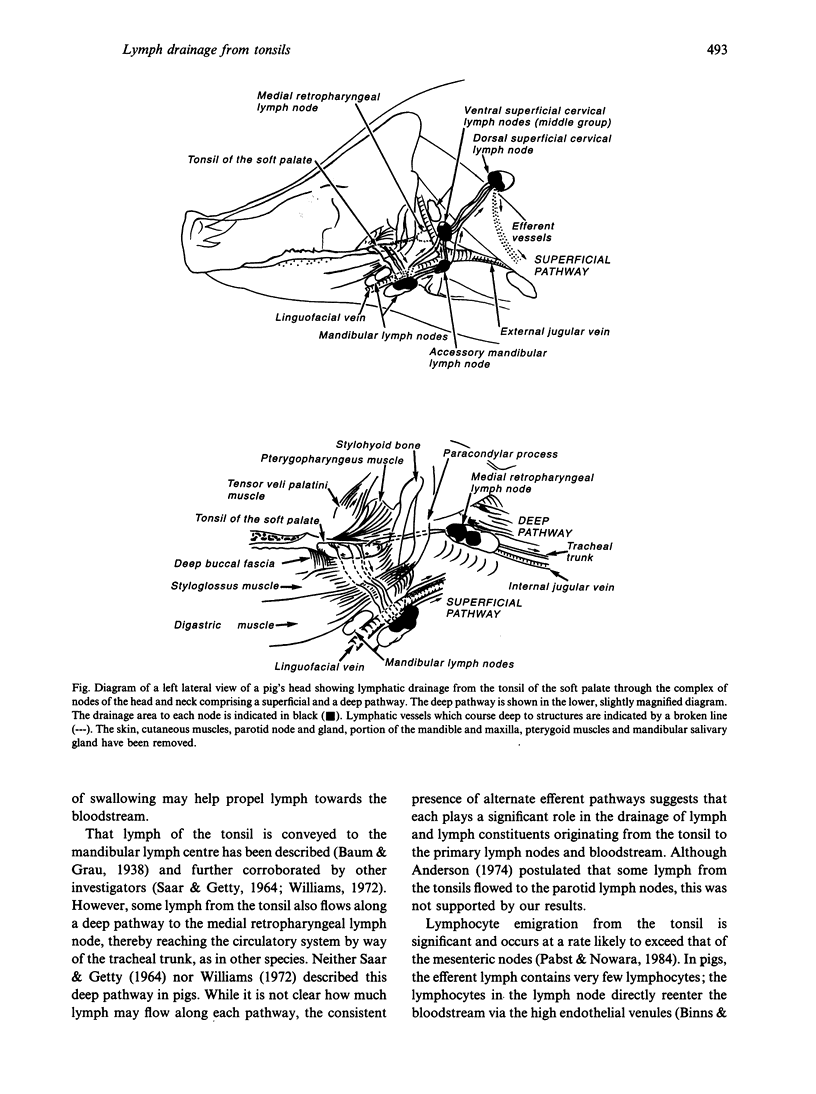
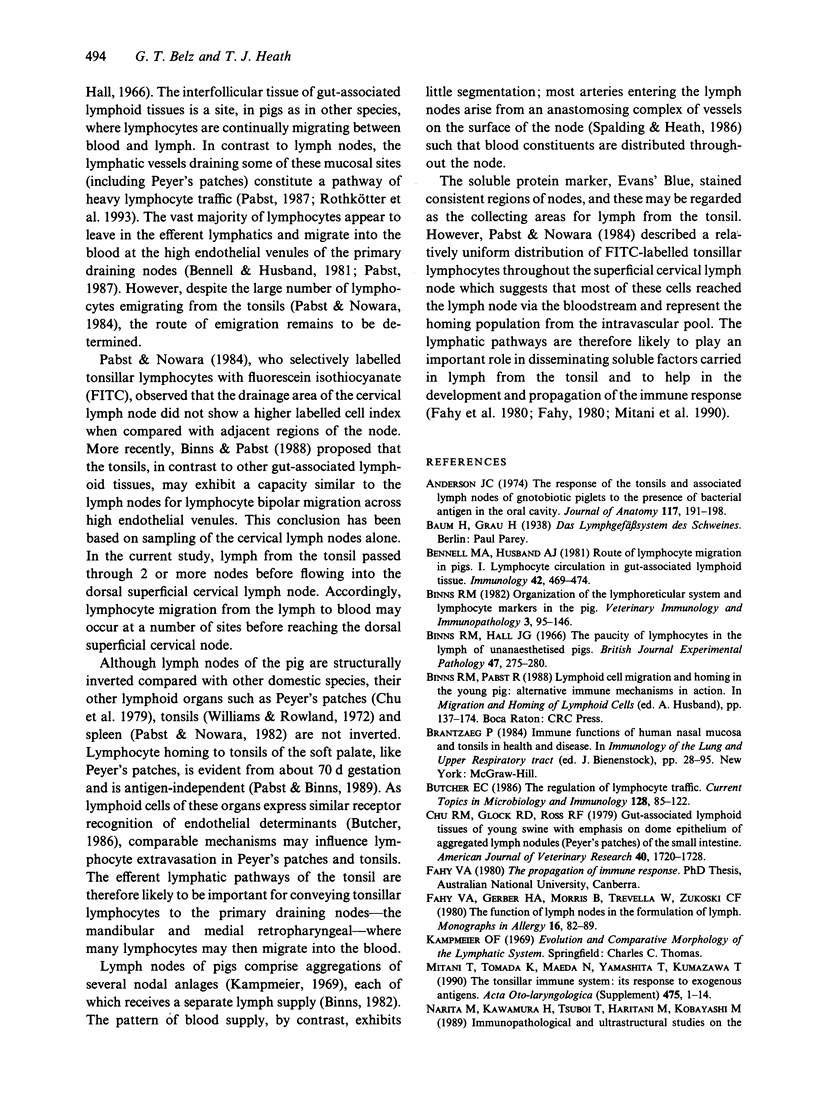
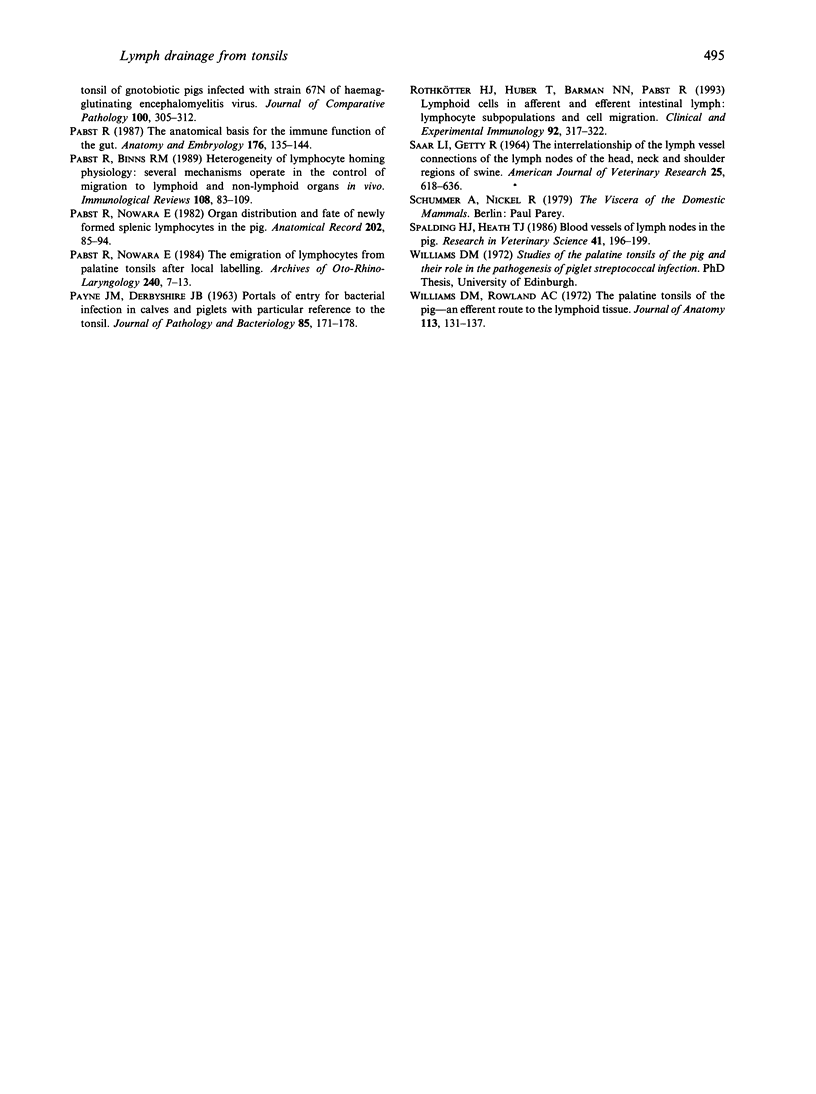
Selected References
These references are in PubMed. This may not be the complete list of references from this article.
- Anderson J. C. The response of the tonsil and associated lymph nodes of gnotobiotic piglets to the presence of bacterial antigen in the oral cavity. J Anat. 1974 Feb;117(Pt 1):191–198. [PMC free article] [PubMed] [Google Scholar]
- Bennell M. A., Husband A. J. Route of lymphocyte migration in pigs. I. Lymphocyte circulation in gut-associated lymphoid tissue. Immunology. 1981 Mar;42(3):469–474. [PMC free article] [PubMed] [Google Scholar]
- Binns R. M. Organisation of the lymphoreticular system and lymphocyte markers in the pig. Vet Immunol Immunopathol. 1982 Jan;3(1-2):95–146. doi: 10.1016/0165-2427(82)90033-2. [DOI] [PubMed] [Google Scholar]
- Butcher E. C. The regulation of lymphocyte traffic. Curr Top Microbiol Immunol. 1986;128:85–122. doi: 10.1007/978-3-642-71272-2_3. [DOI] [PubMed] [Google Scholar]
- Chu R. M., Glock R. D., Ross R. F. Gut-associated lymphoid tissues of young swine with emphasis on dome epithelium of aggregated lymph nodules (Peyer's patches) of the small intestine. Am J Vet Res. 1979 Dec;40(12):1720–1728. [PubMed] [Google Scholar]
- Fahy V. A., Gerber H. A., Morris B., Trevella W., Zukoski C. F. The function of lymph nodes in the formulation of lymph. Monogr Allergy. 1980;16:82–99. [PubMed] [Google Scholar]
- Mitani T., Tomoda K., Maeda N., Yamashita T., Kumazawa T. The tonsillar immune system: its response to exogenous antigens. Acta Otolaryngol Suppl. 1990;475:1–14. doi: 10.3109/00016489009121140. [DOI] [PubMed] [Google Scholar]
- Narita M., Kawamura H., Tsuboi T., Haritani M., Kobayashi M. Immunopathological and ultrastructural studies on the tonsil of gnotobiotic pigs infected with strain 67N of haemagglutinating encephalomyelitis virus. J Comp Pathol. 1989 Apr;100(3):305–312. doi: 10.1016/0021-9975(89)90108-4. [DOI] [PubMed] [Google Scholar]
- PAYNE J. M., DERBYSHIRE J. B. Portals of entry for bacterial infection in calves and piglets with particular reference to the tonsil. J Pathol Bacteriol. 1963 Jan;85:171–178. doi: 10.1002/path.1700850116. [DOI] [PubMed] [Google Scholar]
- Pabst R., Binns R. M. Heterogeneity of lymphocyte homing physiology: several mechanisms operate in the control of migration to lymphoid and non-lymphoid organs in vivo. Immunol Rev. 1989 Apr;108:83–109. doi: 10.1111/j.1600-065x.1989.tb00014.x. [DOI] [PubMed] [Google Scholar]
- Pabst R., Nowara E. Organ distribution and fate of newly formed splenic lymphocytes in the pig. Anat Rec. 1982 Jan;202(1):85–94. doi: 10.1002/ar.1092020110. [DOI] [PubMed] [Google Scholar]
- Pabst R., Nowara E. The emigration of lymphocytes from palatine tonsils after local labelling. Arch Otorhinolaryngol. 1984;240(1):7–13. doi: 10.1007/BF00464338. [DOI] [PubMed] [Google Scholar]
- Pabst R. The anatomical basis for the immune function of the gut. Anat Embryol (Berl) 1987;176(2):135–144. doi: 10.1007/BF00310046. [DOI] [PubMed] [Google Scholar]
- Rothkötter H. J., Huber T., Barman N. N., Pabst R. Lymphoid cells in afferent and efferent intestinal lymph: lymphocyte subpopulations and cell migration. Clin Exp Immunol. 1993 May;92(2):317–322. doi: 10.1111/j.1365-2249.1993.tb03398.x. [DOI] [PMC free article] [PubMed] [Google Scholar]
- SAAR L. I., GETTY R. THE INTERRELATIONSHIP OF THE LYMPH VESSEL CONNECTIONS OF THE LYMPH NODES OF THE HEAD, NECK, AND SHOULDER REGIONS OF SWINE. Am J Vet Res. 1964 May;25:618–636. [PubMed] [Google Scholar]
- Spalding H. J., Heath T. J. Blood vessels of lymph nodes in the pig. Res Vet Sci. 1986 Sep;41(2):196–199. [PubMed] [Google Scholar]
- Williams D. M., Rowland A. C. The palatine tonsils of the pig--an afferent route to the lymphoid tissue. J Anat. 1972 Oct;113(Pt 1):131–137. [PMC free article] [PubMed] [Google Scholar]


